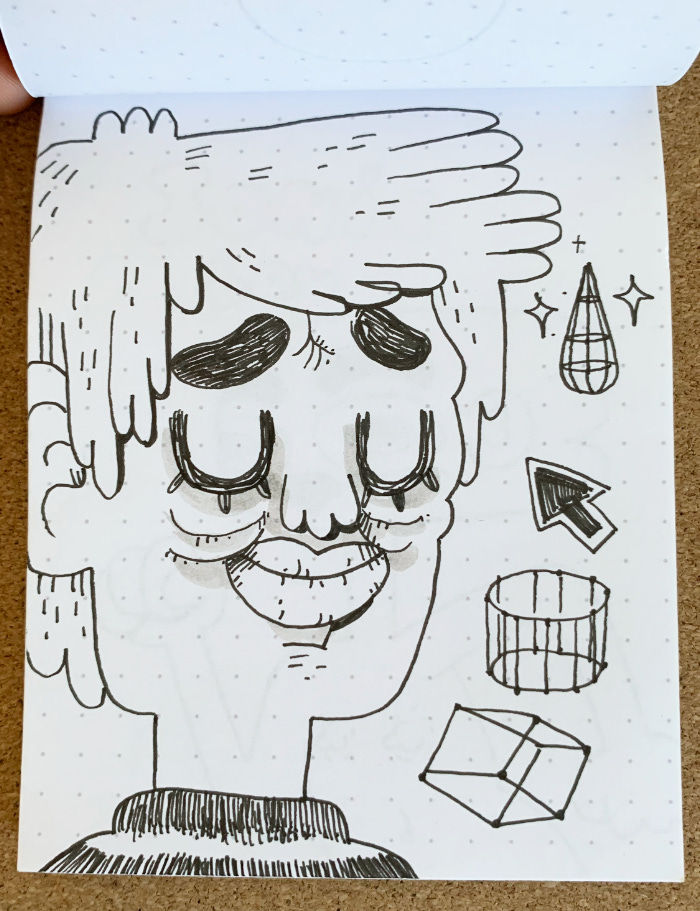Hallå my pals!
Jonas here with another issue of Indie Notebook to get some ideas out of my noggin, and to inspire you to do the same.
I think most of us think of sketchbooks as a place where you do a few things. Practice, do studies, work out ideas or mindlessly doodle. Those are all great uses. But I came up with something that has a specific challenge, which made it a bit more rewarding.
Today I’m gonna show you an alternative to keeping a traditional sketchbook.
80 Page Mini Sketch Pad
On the 22nd of September 2016 I got a spontaneous and irresistible urge to get a very tiny sketchbook with dotted paper. I wanted to try to make each page a tiny illustration so it would be fun to one day flip through it. My goal was to make a one-of-a-kind art book.
I made it a rule to not do any pre-sketching, I just went straight in and tried to be confident with ink directly. It’s not that different from how I usually use sketchbooks, the key difference is that I meant for these to not look sketchy. There was a bunch of failed drawings in the beginning (not showing them today), but they became fewer and fewer. I got better at preparing myself mentally and imagining what to do.
Here’s a couple of pages from it.

Tip: The paper is very light so my copic markers bled through very easily. I just put some paper underneath the page to protect the next one. Worked really well.
On the 28th of September 2023 I filled in the last page, 7 years after drawing the first page. You could say that this sketchpad is the lil sis of The Banana Sketchbook. 80 sheets isn’t that much, so there’s not really any reason for it to take that long, it takes about 20 minutes to draw one of these. I just got forgot it somewhere after a move.
There are way too many pages to put here. I’m thinking of scanning them and making a zine out of it, I just need to get hold of a scanner somewhere.
It was such a joy to make this, I’ll definitely do this again.
Mini Notes
🔴 Youtube video - How your handwriting is the key to drawing better
I never heard this tip before but there’s absolutely some connection to handwriting and art style. Art style might not be the correct word though, maybe “mark making” makes more sense. Because you can make conscious decisions about your art style, it’s much harder to change the way you put strokes down.
It never occurred to me that most lines are either C’s, S’s, or I’s.
🎨 Art - Em Partridge’s tumblr
Emily Partridge’s art had a pretty big influence on me a long time ago. I rediscovered her lately because I’ve been trying to get back into using tumblr. She’s very inactive everywhere, I think she mostly works on Adventure Time.
💬 Web comic - Necropolis
A story about a girl who has her village destroyed and decides to do something about it by getting a big ass sword. I’ve only read the first chapter so far but it’s very well drawn and the story seems promising.
❓ Question time
How do you use your sketchbook?
Thank you for reading Indie Notebook! The best way to support it right now is by sharing it with a friend.
Take care and have a creative week.








It's fun how inspiring a set of rules or limitations can be. The pages you're sharing here turned out really well, I think.
Last week, I handwrote a long poem (which I originally wrote last December) into a little book I have binded myself. It was very interesting to analyze how I normally write vs. how I wanted the text to be presented. I basically ended up creating rulesets for how to do each letter - and once I had those rules in place, it allowed me to breathe some life and motion into the writing of each line without needing to worry about how presentable it would be.
Now, when I write down a shopping list or whatever, I feel more conscious of my writing which used to be a very thoughtless and automatic process. It's something I wouldn't mind exploring more in the future. It would be fun to go in depth with it and basically create a personal "font" as another aspect of one's self-expression.
Calligraphy is the art of drawing pretty letters, but it literally means “beautiful drawing.”
It’s also what inspired Steve Jobs to have the aesthetic sensibilities to create the Mac as something attractive and customizable, and not just functional